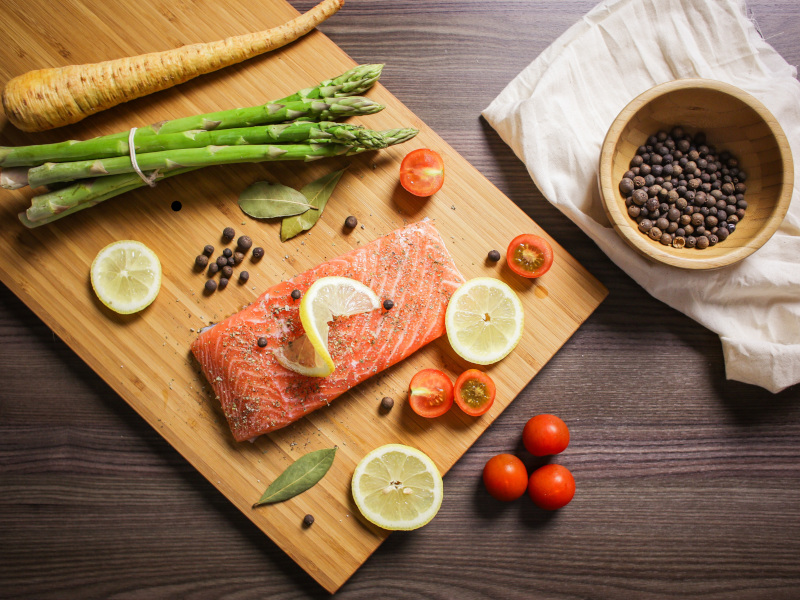Cooking fish is sometimes seemed like a pretty complicated task, especially when you have not much experience in cooking. There is a thin line between completely raw salmon and overcooked one with dry, chewy flesh. Even the skilled chef may time to time mess the fish up with conventional methods of cooking, but sous vide leaves practically no room for error. You can achieve perfectly moist and tender meat every time without the fear of screwing this delicate piece of fish.
Ingredients (2 servings):
- 2 fillets of salmon 0.5 lbs (250 g) each
- 1 teaspoon (5 g) of kosher salt
- 1 teaspoon (5 g) of white pepper
- 1/2 teaspoon of lemon zest
- 1 tablespoon of lemon juice
- a sprig of dill or any of your favorite aromatics
- 1 tablespoon of olive oil
Steps:
- Selection of the Salmon
- Getting Prepared for Cooking (Mise en place)
- Cooking Sous Vide – Temperatures and Time
- Finishing the Salmon
Step 1: Selection of the Meat
Sourcing a fresh fish may be a bit tricky because you surely do not want to buy a piece that has sat on a counter for several days and may even result in unwanted health issues. So how to spot and select fresh fish that is worth your money to spend? Let us look closer to a few signs that will ensure you always get a good one.
Farmed vs. Wild
There are two basic types of salmon, which differ significantly in flavor and texture. Farmed salmon, as the name indicates, is raised under controlled conditions. It has a bright pink flesh with a fair amount of fat. Its taste is mild and almost buttery. Compared to that, a wild salmon has a more pronounced flavor and darker meat with a firmer texture. One is not better than the other. You can try both and find out which you prefer.
Fresh vs. Frozen
Naturally, there is a rule when selecting the right fish, and that is the fresher, the better. But it is sometimes hard to find out whether the fish was frozen or how long it has been sitting on the shelf of the fish counter. The chances that the fish was frozen dramatically increase with the distance from the place where it was caught. If you are living in the inland, far from the sea, even the fresh-looking fish displayed on the shelf may have gone through the freezing process and were thawed later. So if you have no way to verify the age of the fish and whether it was frozen or not, you will need to rely on your senses and its appearance.
Appearance
The overall appearance will be the most significant factor in determining fish quality. It should be bright in color, all the fat should be exclusively white, and it should not have any patches of discoloration. Any brown or grey spots on the fish may indicate that it has been thawed incorrectly or that it is getting old. Also, you should always smell the fish you are buying. It should smell like a sea but not fishy at all. The fishy smell gets more intense with every day it sits on the shelf due to the specific chemical reaction in the meat. Another sign of good quality salmon is the firmness of the meat. When you touch it with your finger, it should bounce back, leaving any marks or holes in the meat. If it feels mushy and soft, it indicates that the fish is older, and you should rather avoid it.
Step 2: Getting Prepared For Cooking (Mise en Place)
Good quality salmon does not need much to do about before you start cooking it. But there is one essential thing that may ruin all the experience for you – the pin bones. Most of the filleted fish are left with a small residual part of the bones that connect the meat to the spine. You need to take care of them to be sure neither you nor any of your guests will choke on them. Run your hand on the meat side from end to end to feel where the bones are. Some use the back of the knife, but be careful not to damage the meat. Use any tweezers you have at hand and pull the bones carefully out. When the fillet is completely clean, season it with salt, white pepper, few drops of lemon juice and a little bit of lemon zest. You may add your favorite herbs like commonly used dill, which goes perfectly with salmon. Add a drop of olive oil to the sous vide bag, and you are ready to go.
Step 3: Cooking Sous Vide – Temperature and Time
Now let’s examine the crucial step in your sous vide cooking – how to set the optimal temperature and how long your salmon needs to be cooked. Below you can see a table which shows you exact numbers and ranges for your salmon. You may also use your sous vide application if your device manufacturer provides one.
Texture | Temperature Range | Timing Range |
|---|---|---|
| Firm, Sashimi-Like | 105 °F (41 °C) to 110°F (43 °C) | 30 to 45 mins |
| Soft and Buttery | 110 °F (43 °C) to 115 °F (46 °C) | 30 to 45 mins |
| Flaky and Translucent | 115 °F (46 °C) to 120°F (49°C) | 30 to 60 mins |
| Moist, tender, and flaky | 120°F (49 °C) to 130 °F (54 °C) | 30 to 60 mins |
| Firm, Moist, and Flaky | 130 °F (54 °C) and up | 30 to 60 mins |
Note: These temperatures and timings apply for salmon only | ||
Because the salmon is a delicate piece of meat, the difference in just one or two degrees can make a big difference in the resulting texture. Also, there is a wider range of the preferred texture amongst people. Some like their salmon almost completely raw, and some enjoy it cooked through on the contrary. And with sous vide machine you always get what you are looking for.
Step 4: Finishing the Salmon
After your salmon has been cooked for the desired temperature and time, it is time to pull it out of the water bath and prepare it for serving. Firstly, you need to pull out the fillets very carefully, so you do not damage the flesh. Use tongs, spatula, or you may even let the fillets slide out naturally on a big plate. You may want to separate the skin (which should be an effortless task) or leave it intact. It is completely up to you. Pat the meat and the skin dry all over and season it mildly with a pinch of salt again.
When searing the fish, it is more convenient to use the non-stick pan rather than the cast-iron. When the fish sticks to the bottom, it is almost impossible to handle the situation without completely ruining it. If you want to be 100% sure that anything will not stick, place a baking paper on the bottom of the pan before you pour in the olive oil. You can place the fillet on the top, and the heat will easily go through. Sear your salmon until it has the desired color, or the skin is crispy. You should be ready to serve now.

